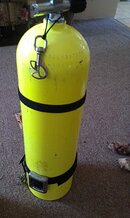terri717
Registered
I'm completing (well, hopefully) my OW this weekend and I'm having a "foot" problem! Everyone thinks I'm weird when I say "my feet float", but I don't know how else to describe it. When I'm trying to descend, my feet float upward, so I'm not able to keep the 'fins down' position like most others. Also, when I'm at the top and am positively buoyant in my BCD my feet continually roll behind my body making me face plant the water or kick around like a fish out of water to stay upright. My husband says "just lean back on your tank and have your feet in front of you". But, when I do this and relax, my legs begin to rotate under and behind me. During our pool dives, again, my feet wouldn't stay down I finally just held on to my heels with my hands so I could stop being led by my feet. The problem with all of this is, beyond a descent nightmare, my back hurts from being so arched. I am wearing 7mm boots with fins that appear positively buoyant as they float on the surface. My husband's slowly sink. In the OW we are wearing 7mm wet suits. I'm average build but most of my weight is in the rump, as I have a long narrow torso but shorter legs. As long as I can complete the OW I'll be happy for now, but I can't imagine struggling like this on all dives. I'm thinking of ankle weights....worth a shot?




